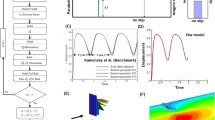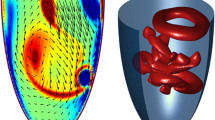Abstract
In this paper, the hemodynamic characteristics inside a physiologically correct three-dimensional LV model using fluid structure interaction scheme are examined under various heart beat conditions during early filling wave (E-wave), diastasis and atrial contraction wave (A-wave). The time dependent and incompressible viscous fluid, nonlinear viscous fluid and the stress tensor equations are coupled with the full Navier–Stoke’s equations together with the Arbitrary Lagrangian–Eulerian and elasticity in the solid domain are used in the analysis. The results are discussed in terms of the variation in the intraventricular pressure, wall shear stress (WSS) and the fluid flow patterns inside the LV model. Moreover, changes in the magnitude of displacements on the LV are also observed during diastole period. The results obtained demonstrate that the magnitude of the intraventricle pressure is found higher in the basal region of the LV during the beginning of the E-wave and A-wave, whereas the Ip is found much higher in the apical region when the flow propagation is in peak E-wave, peak A-wave and diastasis. The magnitude of the pressure is found to be 5.4E2 Pa during the peak E-wave. Additionally, WSS elevates with the rise in the E-wave and A-wave but the magnitude decreases during the diastasis phase. During the peak E-wave, maximum WSS is found to be 5.7 Pa. Subsequent developments, merging and shifting of the vortices are observed throughout the filling wave. Formations of clockwise vortices are evident during the peak E-wave and at the onset of the A-wave, but counter clockwise vortices are found at the end of the diastasis and at the beginning of the A-wave. Moreover, the maximum magnitude of the structural displacement is seen in the ventricle apex with the value of 3.7E−5 m.








Similar content being viewed by others
References
Kouhi E (2011) An advanced fluid structure interaction study of tri-leaflet aortic heart valve. Swinburne University of Technology, Melbourne
De Hart J, Peters GWM, Schreurs PJG, Baaijens FPT (2000) A two-dimensional fluid–structure interaction model of the aortic value. J Biomech 33(9):1079–1088. doi:10.1016/S0021-9290(00)00068-3
Morsi YS, Yang WW, Wong CS, Das S (2007) Transient fluid–structure coupling for simulation of a trileaflet heart valve using weak coupling. J Artif Organs 10(2):96–103. doi:10.1007/s10047-006-0365-9
Marom G, Peleg M, Halevi R, Rosenfeld M, Raanani E, Hamdan A, Haj-Ali R (2013) Fluid–structure interaction model of aortic valve with porcine-specific collagen fiber alignment in the cusps. J Biomech Eng 135(10):101001–101006. doi:10.1115/1.4024824
Kemp I, Dellimore K, Rodriguez R, Scheffer C, Blaine D, Weich H, Doubell A (2013) Experimental validation of the fluid-structure interaction simulation of a bioprosthetic aortic heart valve. Australas Phys Eng Sci Med 36(3):363–373. doi:10.1007/s13246-013-0213-1
Kouhi E, Morsi Y, Hassan Masood S (2008) Two way FSI analysis of CABG with physiologically realistic pulsatile flow and nonlinear artery structure. J Biomech 41:S245
Morsi Y, Owida A, Do H, Arefin MS, Wang X (2012) Graft-artery junctions: design optimization and CAD development. In: Liebschner MAK (ed) Computer-aided tissue engineering. Methods in molecular biology, vol 868. Humana Press, Totowa, pp 269–287. doi:10.1007/978-1-61779-764-4_16
Do HV (2012) Design and optimization of coronary arteries bypass graft using numerical method. Swinburne University of Technology, New York
Freshwater IJMY, Lai T (2006) The effect of angle on wall shear stresses in a LIMA to LAD anastomosis: numerical modelling of pulsatile flow. Proc Inst Mech Eng H 220(7):743–757
Kouhi E, Morsi Y, Masood SH (2009) The effect of arterial wall deformability on hemodynamics of CABG. pp 485–494
Ong CW, Chan BT, Lim E, Abu Osman NA, Abed AA, Dokos S, Lovell NH (2012) Fluid structure interaction simulation of left ventricular flow dynamics under left ventricular assist device support. In: 34th Annual international conference of the IEEE EMBS, pp. 6293-6296
Zheng X, Seo JH, Vedula V, Abraham T, Mittal R (2012) Computational modeling and analysis of intracardiac flows in simple models of the left ventricle. Eur J Mech 35:31–39. doi:10.1016/j.euromechflu.2012.03.002
Cheng Y, Oertel H, Schenkel T (2005) Fluid–structure coupled CFD simulation of the left ventricular flow during filling phase. Ann Biomed Eng 33:567–576. doi:10.1007/s10439-005-4388-9
Tang D, Yang C, Geva T, Nido PJd (2010) Image-based patient-specific ventricle models with fluid–structure interaction for cardiac function assessment and surgical design optimization. Prog Pediatr Cardiol 30(1–2):51–62
Nordsletten D, McCormick M, Kilner PJ, Hunter P, Kay D, Smith NP (2011) Fluid–solid coupling for the investigation of diastolic and systolic human left ventricular function. Int J Numer Methods Biomed Eng 27(7):1017–1039. doi:10.1002/cnm.1405
Hunter PJ, Pullan AJ, Smaill BH (2003) Modeling total heart function. Annu Rev Biomed Eng 5:147–177. doi:10.1146/annurev.bioeng.5.040202.121537
Khalafvand SS, Ng EYK, Zhong L (2011) CFD simulation of flow through heart: a perspective review. Comput Methods Biomech Biomed Eng 14(1):113–132
Lee B-K (2011) Computational fluid dynamics in cardiovascular disease. Korean Circ J 41(8):423–430
Versteeg HK, Malalasekera W (2007) An introduction to computational fluid dynamics. The finite volume method, 2nd edn. Pearson, Harlow
Tu J, Yeoh GH, Liu C (2008) Computational fluid dynamics: a practical approach. Elsevier, Burlington
McQueen DM, Peskin CS (2000) A three-dimensional computer model of the human heart for studying cardiac fluid dynamics. ACM SIGGRAPH Comput Graph 34(1):56–60
Ding J, Liu Y, Wang F, Bai F (2012) Impact of competitive flow on hemodynamics in coronary surgery: numerical study of ITA-LAD model. Comput Math Methods Med 2012:7. doi:10.1155/2012/356187
Reul H, Talukder N, Müller EW (1981) Fluid mechanics of the natural mitral valve. J Biomech 14(5):361–372. doi:10.1016/0021-9290(81)90046-4
Taylor TW, Okino H, Yamaguchi T (1994) Three-dimensional analysis of left ventricular ejection using computational fluid dynamics. J Biomech Eng 116(1):127–130. doi:10.1115/1.2895696
Vierendeels JA, Riemslagh K, Dick E, Verdonck P (1999) Computer simulation of left ventricular filling flow: impact study on echocardiograms. Comput Cardiol 1999(1999):177–180. doi:10.1109/CIC.1999.825935
Lemmon JD, Yoganathan AP (2000) Computational modeling of left heart diastolic function: examination of ventricular dysfunction. J Biomech Eng 122(4):297–303
Verdonck P, Vierendeels J (2002) Fluid–structure interaction modelling of left ventricular filling. In: Sloot PA, Hoekstra A, Tan CJK, Dongarra J (eds) Computational science: ICCS 2002. Lecture notes in computer science, vol 2331. Springer, Berlin, pp 275–284. doi:10.1007/3-540-47789-6_29
Nakamura M, Wada S, Mikami T, Kitabatake A, Karino T (2002) A computational fluid mechanical study on the effects of opening and closing of the mitral orifice on a transmitral flow velocity profile and an early diastolic intraventricular flow. JSME Int J Ser C 45(4):913–922
Ebbers T, Bolger AF, Wranne B, Karlsson M, Wigström L (2002) Noninvasive measurement of time-varying three-dimensional relative pressure fields within the human heart. J Biomech Eng 124(3):288–293. doi:10.1115/1.1468866
Saber N, Wood N, Gosman AD, Merrifield R, Yang G-Z, Charrier C, Gatehouse P, Firmin D (2003) Progress towards patient-specific computational flow modeling of the left heart via combination of magnetic resonance imaging with computational fluid dynamics. Ann Biomed Eng 31(1):42–52. doi:10.1114/1.1533073
Long Q, Merrifield R, Yang G, Kilner P, Firmin D, Xu X (2003) The influence of inflow boundary conditions on intra left ventricle flow predictions. J Biomech Eng 125(6):922–927
Usyk TP, McCulloch AD (2003) Relationship between regional shortening and asynchronous electrical activation in a three-dimensional model of ventricular electromechanics. J Cardiovasc Electrophysiol 14:S196–S202. doi:10.1046/j.1540.8167.90311.x
Kerckhoffs RCP, Faris OP, Bovendeerd PHM, Prinzen FW, Smits K, McVeigh ER, Arts T (2003) Timing of depolarization and contraction in the paced canine left ventricle. J Cardiovasc Electrophysiol 14:S188–S195. doi:10.1046/j.1540.8167.90310.x
Kilner PJ, Yang G-Z, Wilkes AJ, Mohiaddin RH, Firmin DN, Yacoub MH (2000) Asymmetric redirection of flow through the heart. Nature 404(6779): 759–761. http://www.nature.com/nature/journal/v404/n6779/suppinfo/404759a0_S1.html
Saber N, Gosman AD, Wood N, Kilner P, Charrier C, Firmin D (2001) Computational flow modeling of the left ventricle based on in vivo MRI data: initial experience. Ann Biomed Eng 29(4):275–283. doi:10.1114/1.1359452
Watanabe H, Sugiura S, Kafuku H, Hisada T (2004) Multiphysics simulation of left ventricular filling dynamics using fluid-structure interaction finite element method. Biophys J 87(3):2074–2085
Domenichini F, Pedrizzetti G, Baccani B (2005) Three-dimensional filling flow into a model left ventricle. J Fluid Mech 539:179–198. doi:10.1017/S0022112005005550
Pedrizzetti G, Domenichini F (2005) Nature optimizes the swirling flow in the human left ventricle. Phys Rev Lett 95(10):108101. doi:10.1103/PhysRevLett.95.108101
Lee J, Niederer S, Nordsletten D, Grice IL, Smail B, Kay D, Smith N (2009) Coupling contraction, excitation, ventricular and coronary blood flow across scale and physics in the heart. Philos Trans R Soc A 367(1986):2311–2331. doi:10.1098/rsta.2008.0311
Nordsletten DA, Niederer SA, Nash MP, Hunter PJ, Smith NP (2011) Coupling multi-physics models to cardiac mechanics. Prog Biophys Mol Biol 104(1–3):77–88
Lassila T, Malossi ACI, Stevanella M, Votta E, Redaelli A, Deparis S (2012) Multiscale fluid–structure interaction simulation of patient-specific left ventricle fluid dynamics with fictitious elastic structure regularization. Int J Numer Methods Biomed Eng 00:1–23. doi:10.1002/cnm
Temam R (2001) Navier–Stokes equations: theory and numerical analysis. AMS Chelsea Publishing, Providence
Fluid–Structure Interaction (2013) http://www.ansys.com/Products/Simulation+Technology/Fluid+Dynamics/Fluid+Dynamics+Products/ANSYS+Fluent/Features/Fluid%E2%80%93Structure+Interaction. Accessed 25 Oct 2013
Huerta A, Liu WK (1998) Viscous flow with large free surface motion. Comput Methods Appl Mech Eng 69(3):277–324
Donea J, Huerta A, Ponthot J-P, Rodr′ıguez-Ferran A (2004) Arbitrary Lagrangian–Eulerian methods. Encyclopedia of computational mechanics, vol 1. Wiley, New York
Patankar SV, Spalding DB (1972) A calculation procedure for heat, mass and momentum transfer in 3-D parabolic flows. Int J Heat Mass Transf 15:1787–1806
Bronzino JD (1999) The biomedical engineering handbook, 2nd edn. CRC Press, Boca Raton
Bronzino JD (2006) Biomedical engineering fundamentals, 3rd edn. CRC Press, Boca Raton
Waite L, Schulz S, Szabo G, Vahl CF (2000) A lumped parameter model of left ventricular filling-pressure waveforms. Biomed Sci Instrum 36:75–80
Courtois M, Kovács SJ Jr, Ludbrook PA (1988) Transmitral pressure–flow velocity relation. Importance of regional pressure gradients in the left ventricle during diastole. Circulation 78(3):661–671. doi:10.1161/01.CIR.78.3.661
Nagueh SF, Appleton CP, Gillebert TC, Marino PN, Oh JK, Smiseth OA, Waggoner AD, Flachskampf FA, Pellikka PA, Evangelisa A (2009) Recommendations for the evaluation of left ventricular diastolic function by echocardiography. Eur J Echocardiogr 10(2):165–193. doi:10.1093/ejechocard/jep007
Author information
Authors and Affiliations
Corresponding author
Rights and permissions
About this article
Cite this article
Arefin, M.S., Morsi, Y.S. Fluid structure interaction (FSI) simulation of the left ventricle (LV) during the early filling wave (E-wave), diastasis and atrial contraction wave (A-wave). Australas Phys Eng Sci Med 37, 413–423 (2014). https://doi.org/10.1007/s13246-014-0250-4
Received:
Accepted:
Published:
Issue Date:
DOI: https://doi.org/10.1007/s13246-014-0250-4




